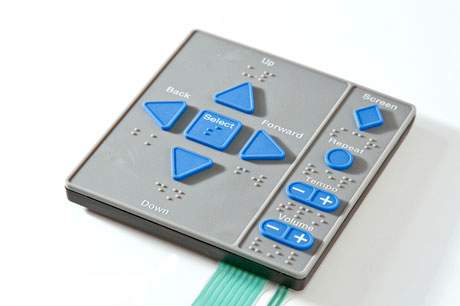The Environmental Benefits of Choosing Membrane Switches for Your Products
The Environmental Benefits of Choosing Membrane Switches for Your Products
Blog Article
Comprehending the Importance of Membrane Switches in Customer User Interfaces
Membrane switches are essential parts in the layout of efficient interface, helping with not just functionality yet additionally enhancing visual allure and individual communication. Their unique attributes, such as resistance to customizable layouts and ecological variables, make them appropriate for a diverse array of applications across several sectors. As we check out the various benefits and future trends connected with Membrane innovation, it ends up being clear that these switches are much more than just elements; they stand for a convergence of innovation and usefulness. The ramifications of this technology on customer experience are worth checking out better.
What Are Membrane Buttons?

The spacer layer, which includes glue residential or commercial properties, enables the separation of the circuit layer from the overlay, guaranteeing that the switch continues to be in a non-activated state till pushed. When stress is applied to the overlay, it compresses the spacer layer, connecting the space and finishing the circuit in the underlying layer. This design not only lowers the physical space needed for conventional mechanical switches however additionally enhances the longevity of the tool, as Membrane switches are typically immune to dirt, moisture, and other environmental aspects.
Typically found in applications ranging from customer electronics to medical tools, Membrane switches are integral to contemporary technology, giving a efficient and user-friendly interface that aligns with contemporary design requirements.
Benefits of Membrane Switches
While numerous button technologies exist, Membrane Switches offer unique benefits that make them particularly preferable in numerous applications. Among the primary benefits of Membrane switches is their compact layout, which allows for space-saving implementations in devices where property is restricted. Their thin account not just boosts visual charm yet additionally facilitates light-weight building and construction.
An additional substantial advantage is their resistance to environmental aspects. Membrane switches are normally secured against wetness, dirt, and pollutants, making them excellent for usage sought after settings, such as clinical gadgets and commercial equipment. This longevity expands the life-span of the button, lowering maintenance prices and boosting integrity.
Furthermore, Membrane buttons can be tailored to fulfill specific style demands, including unique graphics and shades that improve customer communication. Their tactile feedback options can likewise be tailored to offer an enjoyable user experience. In addition, Membrane switches are cost-effective, particularly in high-volume applications, as they can be produced successfully.
Applications in Various Industries

In the customer electronics field, Membrane switches prevail in devices such as microwaves, cleaning equipments, and push-button controls. Their tactile feedback and aesthetic choices improve individual experience while offering a streamlined, modern appearance. navigate to this site In addition, auto makers make use of Membrane buttons in control panel controls and infomercial systems, where room is restricted, and user involvement is important.
Additionally, the commercial market leverages Membrane switches in control panels for equipment and equipment, enabling intuitive operation in frequently severe environments. Their resistance to chemicals and moisture ensures durability and integrity in these applications. Overall, the flexibility of Membrane Switches contributes dramatically to their prevalent usage, making them indispensable in numerous technical domain names.
Design Factors To Consider for Membrane Buttons

When making Membrane switches, a number of crucial considerations need to be considered to make sure optimal functionality and individual experience. The option of products is essential; selecting long lasting, high-quality substrates can boost the button's durability and resistance to environmental aspects such as moisture and temperature level variations.
Second of all, the layout of the visuals overlay should focus on clarity and ease of usage. Icons and text have to be understandable, and the design should assist in user-friendly communication (membrane switches). Additionally, responsive responses is vital; incorporating a tactile dome or various other devices can enhance the individual experience by supplying physical confirmation of activation
An additional vital element is the switch's electrical performance. Designers need to ensure that the conductive traces are effectively developed to decrease resistance and avoid signal disturbance. This includes evaluating the called for actuation pressure and ensuring compatibility with the digital elements they will interface with.

Future Patterns in Membrane Innovation
As technology remains to breakthrough, Membrane buttons are positioned to advance dramatically, driven by innovations in products and manufacturing strategies. One emerging pattern is the consolidation of advanced products, such as conductive inks and versatile substrates, which improve durability and decrease the general weight of Membrane buttons. These materials not only enhance the navigate to this site tactile feedback yet likewise permit the layout of buttons that can hold up against harsher ecological conditions.
In addition, the integration of touch-sensitive modern technologies is changing typical Membrane Switches right into more interactive individual interfaces. Capacitive touch sensing units embedded within Membrane button panels can give a more receptive and intuitive user experience, straightening with the growing demand for sleek, contemporary layouts in consumer electronics.
In addition, innovations in printing strategies, such as digital and 3D printing, make it possible for quick prototyping and personalization of Membrane buttons. This adaptability permits producers to react quicker to market demands and consumer preferences.
Finally, sustainability is coming to be a considerable focus, with makers checking out eco-friendly products and procedures. As these fads unravel, the future of Membrane innovation promises boosted performance, aesthetic charm, and environmental duty, strengthening their role in advanced user interfaces across numerous industries.
Final Thought
To conclude, Membrane Switches represent an important element in the style of interface, integrating performance with visual versatility. Their advantages, including sturdiness and resistance to environmental aspects, make them appropriate for varied applications throughout numerous industries. Additionally, thoughtful design factors to consider enhance customer communication and experience. As improvements in innovation proceed, the evolution Clicking Here of Membrane switches is anticipated to further improve user interfaces, driving development and improving usability in an increasingly complicated technological landscape.
Membrane buttons are important parts in the layout of effective user interfaces, facilitating not just capability but also enhancing aesthetic appeal and individual interaction.Membrane Switches offer as an important part in different user interfaces, assisting in a smooth communication between customers and digital gadgets.While numerous switch innovations exist, Membrane Switches offer distinct benefits that make them particularly desirable in different applications.Moreover, Membrane switches can be personalized to fulfill specific design needs, including one-of-a-kind graphics and shades that enhance individual interaction.In final thought, Membrane Switches stand for a crucial component in the design of customer interfaces, incorporating capability with aesthetic flexibility.
Report this page